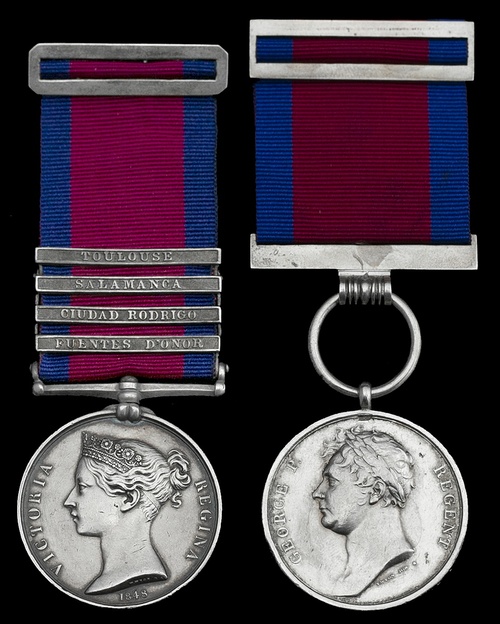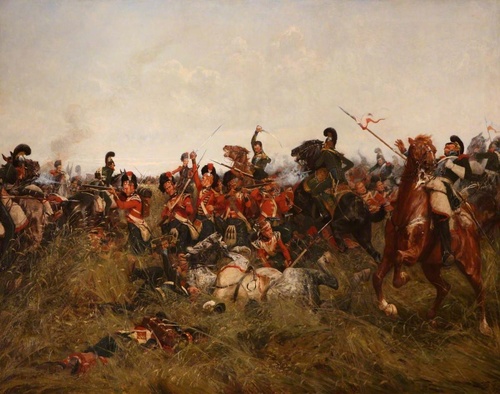Auction: 19001 - Orders, Decorations and Medals
Lot: 589
Pair: Private A. Holmes, 42nd Foot, who was wounded in the head and neck at Waterloo
Military General Service 1793-1814, 4 clasps, Fuentes d'Onor, Ciudad Rodrigo, Salamanca, Toulouse (Arthur Holmes, 42nd Foot); Waterloo 1815 (Arthur Holmes, 42nd or R.H. Reg. Infantry.), with contemporary silver ring and loop suspension, the latter partially officially corrected, minor edge bruise, very fine, both with silver top riband buckles (2)
Arthur Holmes was born at Rosskeen, Ross-shire in 1789. After working as a labourer he enlisted into the 2nd Battalion, 42nd (Royal Highland) Regiment of Foot on 6 February 1807. Raised in 1803, the 2nd Battalion served under Wellington in the Peninsular Campaign from 1810, forming part of Lord Blantyre's Division at the Battle of Busaco on 27 September. The 'Black Watch' played a minor role in this action, and did not receive it as a battle honour until 1910. A far more serious engagement was Fuentes d'Onor (clasp) on 3-5 May 1811. While besieging the French garrison at Almeida, Wellington's position at Fuentes d'Onor was attacked by Marshal Masséna. The 42nd bravely repulsed Masséna's cavalry, who were about to attack Craufurd's exposed Light Division. The 42nd achieved this with the loss of just one Sergeant and one Private killed.
In May 1812, the Black Watch's 1st Battalion re-joined Wellington's army. Holmes was among hundreds of men drafted into it from the 2nd Battalion, which then returned to Scotland. The 1st Battalion were held in reserve at Salamanca (clasp) on 22 July 1812, but suffered terribly during the Siege of Burgos from 19 September to 21 October. Ordered to capture an outerwork known as the San Miguel Hornwork, the 42nd launched a night attack before the artillery bombardment had started. The Battalion was spotted by the French in the moonlight and sustained 200 casualties.
News of Napoleon's abdication on 4 April 1814 had not reached Wellington's army by 10 April, when it attacked the city of Toulouse (clasp), defended by Marshal Soult. Here the 42nd sustained their heaviest losses of the Peninsular War, General Clinton having assigned them the honour of leading the British advance. The 42nd attacked a series of redoubts over open ground, and were subjected to withering canister fire. French troops in nearby houses enfiladed their flanks. The Battalion was reduced from an effective strength of over 500 to just 2 officers and 60 men.
Holmes served in the 1815 Waterloo Campaign as a Private in Captain Daniel McIntosh's Company, 1st Battalion, 42nd Foot. Led by the charismatic Lieutenant-Colonel Robert Macara K.C.B., the 42nd were quartered in Brussels when Napoleon crossed the Sambre. Part of Sir Denis Pack's Brigade in Picton's 5th Division, the Regiment lived up to its old reputation at Quatre Bras on 16 June. Positioned south of the Namur-Nivelles road, the 42nd saw squadrons of cavalry approaching but were unsure whether to open fire. Their uniforms appeared Dutch-Belgian rather than French, and the standing corn hampered identification. The cavalry, French lancers of Werthier's Brigade, were virtually upon the 42nd before they realised what was happening. Showing remarkable discipline, the 42nd managed to form square with a squadron of French lancers trapped inside! These were bayoneted in a ferocious mêlée which cost Macara his life. At Quatre Bras the 42nd sustained casualties of 4 officers and 50 men killed, 22 officers and 337 men wounded. By the close of battle they were obliged to form a joint square with the 44th Foot, so reduced were their numbers.
At the Battle of Waterloo on 18 June, the much-depleted 42nd Foot were placed on the reverse slope to the centre-left of Wellington's line, behind the farmhouse of La Haye Sainte. Subjected to relentless bombardment by the Grand Battery's 12-pounder guns, which Napoleon perversely called his 'Beautiful Daughters', the 42nd took part in the repulse of D'Erlon's Corps at 1.30 p.m. and helped stiffen the Allied centre when La Haye Sainte fell at 6 p.m. It was perhaps during this phase that Holmes received his wounds to the head and neck (his discharge papers confirm), possibly the result of shell-fire from French howitzers positioned near La Haye Sainte. The Battalion advanced with a great cheer when the Imperial Guard recoiled at 8 p.m.
Holmes was discharged on 30 June 1824, after 19 years and 146 days with the Colours; sold with copied discharge papers, roll confirmation and clasp entitlement.
Subject to 20% VAT on Buyer’s Premium. For more information please view Terms and Conditions for Buyers.
Sold for
£3,200







